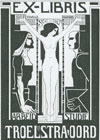Socialist Ex Libris
Introduction
 An ex libris, mark of ownership in a book or manuscript, is both a sample of printing and a piece of art. As art, it is an individual statement by the designer, but it also reflects the personality of the owner. To the artist, designing an ex libris is an enjoyable extra alongside his or her real work, a kind of gift. As a rule, designer and customer were already friends or acquaintances.
An ex libris, mark of ownership in a book or manuscript, is both a sample of printing and a piece of art. As art, it is an individual statement by the designer, but it also reflects the personality of the owner. To the artist, designing an ex libris is an enjoyable extra alongside his or her real work, a kind of gift. As a rule, designer and customer were already friends or acquaintances.
In the Dutch labor movement the bookplate was unknown before 1900. Initially, only the leaders could afford a book collection with such a plate. During the 1930s, when the publishing houses Wereldbibliotheek and De Arbeiderspers printed inexpensive book editions for workers, the ex libris was introduced in these circles on a very modest scale. The ex libris of the Dutch labor movement are not richly endowed with information about the personality of the owner, except for clues to his name: a wolf for Mr. De Wolff or a rooster for Albert Hahn (hahn=rooster). Instead, they represent in symbolic language the hope for a better future, the power of collective action within the socialist movement.
The graphic of the early labor movement was full of symbols. Flames, rising suns, goddesses of freedom, and clenched fists adorned the posters, prints, book covers, and other products of socialist culture. These symbols brought a clear message that could easily be understood by everybody. After 1940 this specific repertoire of socialist symbols almost totally faded away.
In the ex libris presented here, dating from 1905 to 1940, different styles may be discerned. Jugendstil or Art Nouveau is followed by Neue Sachlichkeit or New Objectivity. The nature-inspired shapes of Jugendstil with its meandering leaves, flames, and waves gave way to the simplified line patterns and surfaces of the Neue Sachlichkeit, the design style born in Germany in the 1920s.
The turn from Jugendstil to New Objectivity is very obvious in the work of the most important graphic designer of Dutch social democrary, Fré Cohen. Designing a bookplate was her favorite activity. Her elder colleague Albert Hahn, Sr., who became renowned as a political cartoonist, was strongly influenced by Jugendstil. The communist artist, Chris Beekman, started his work in "De Stijl", but later turned to figurative art. The combination of graphic arts and socialism made the first half of the twentieth century the Golden Age of socialist symbolism.
Text: Margreet Schrevel
